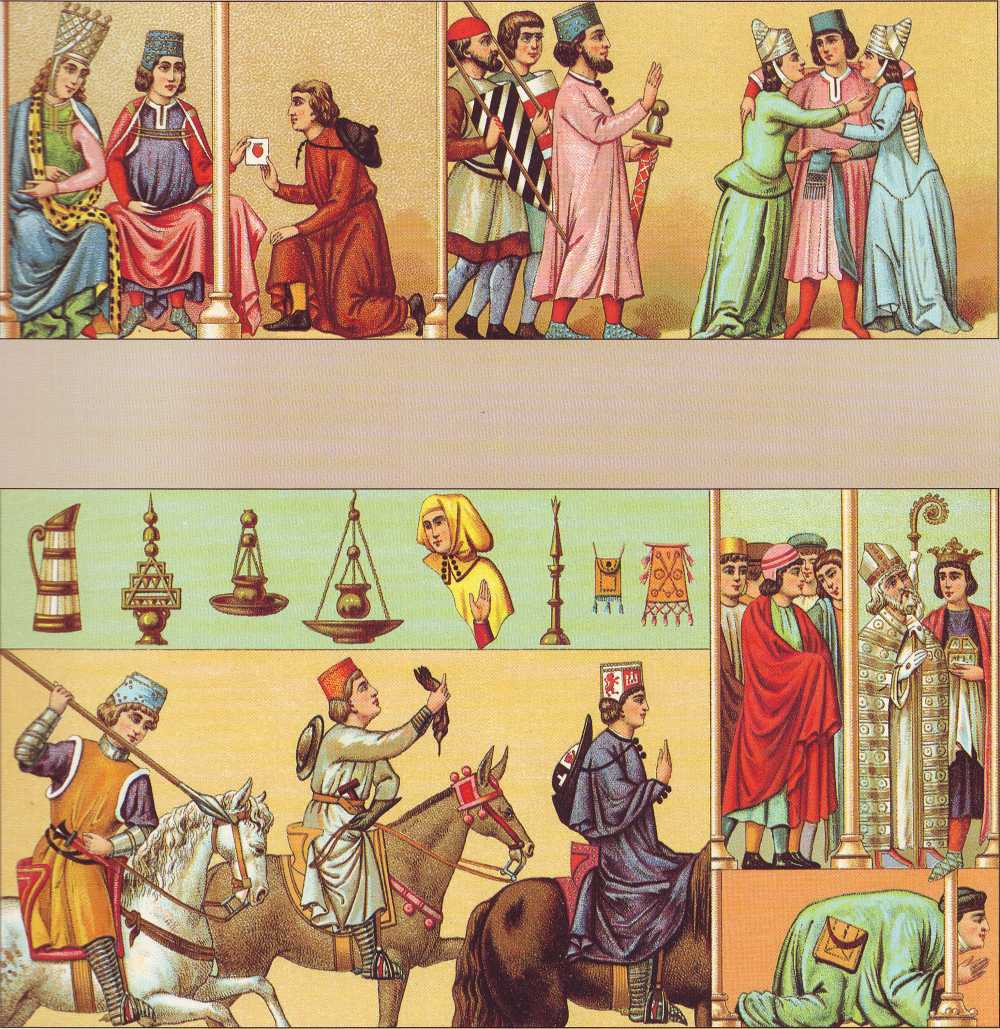 A larger image of the lower register. |
THE PERIOD THAT SAW THE DEFEAT of the Moslems and the move towards unity in Spain marked a corresponding change in costume. Most nations, following the example of the French, shook off Byzantine influence and adopted clothing more suited to the ideals of the Middle Ages. Spain was no exception. It preserved some of the traditions left behind by many centuries of foreign rule, but aspired to a much greater simplicity in costume. The nobility wore little jewellery, and, in general, costume bore the mark of austerity.
Austerity was the keynote of the reign of Alphonse X, known as "the Wise". His rulings went as far as to prohibit the wearing of an under-shirt next to the skin.
His successor, Alphonse XI, continued with sartorial reforms, making laws that prohibited the embellishment of garments with pearls or silver and banned the Oriental-style luxury that still predominated in horses' trappings, with their lavish caparisons and bells. His success can be seen in 2.1.
1.1 A young lady wearing a tiara of fine, embroidered material, decorated with pearls and precious stones and secured on the head by means of a barbuquejo - a wide ribbon passed underneath the chin. Despite the edicts of Alphonse X, the height of such headdresses increased during the last years of his reign.
Her hair hangs down in thick curls over her shoulders; this was the popular style among young Spanish girls. She is wearing the cloak, or pallium, that was worn by both noblemen and women and beneath it a pair of robes: a cyclas and a loba.
The man sitting at her side wears the same garments. The servant, clothed in a tunic made of coarse, brown wool of Saracen origin, is handing him a sealed letter.
1.2 A group of soldiers, whose leader is wearing a white loba.
1.3 Two women offering a man a faja - a scarf with fringes. Their tiaras are similar to the horn-shaped hats worn by Venetian ladies. The woman on the left is wearing a cyclas that takes the place of a bodice, whereas the woman on the right has a long tunic.
 A larger image of the lower register. |
2.1 (top) Examples of 13th-century Spanish furnishings: a wooden pitcher, decorated with bronze; a lamp on a stand; types of hanging lamps with vessels for oil and saucers, as used by Arabs; and a brass candlestick with extinguisher.
The item of clothing is an aumusse, worn by laymen when out of doors.
2.1 (bottom) Huntsmen. The horseman on the left is wearing an embroidered bonnet that comes down over his ears, a quezote - a sleeveless tunic lined with ermine - and greaves. The central character has a leather bonnet, greaves and a hat hanging down his back, and is hunting with a hawk.
The figure on the right is Alphonse X, wrapped in a gonelle, complete with a cape. This garment was always worn without a belt for hunting in the country.
2.2 Alphonse X, carrying a reliquary at the head of a procession. He is wearing a red pallium and an eight-pointed crown. Beside him, a bishop, wearing an embroidered cape, is blessing the crowd.